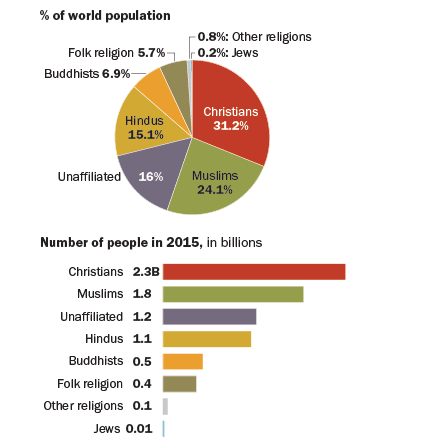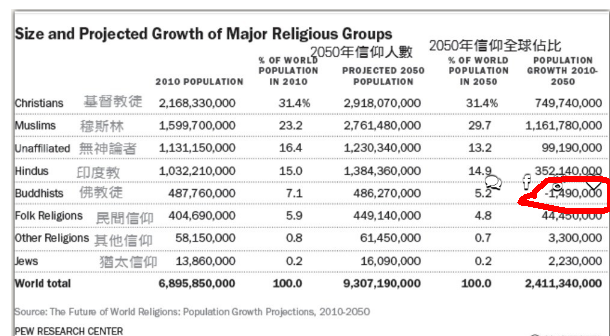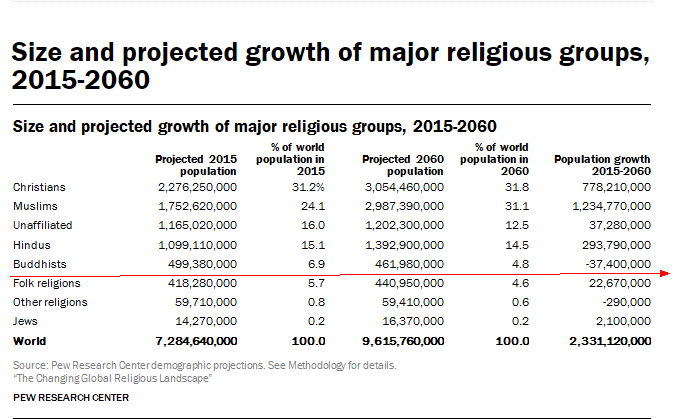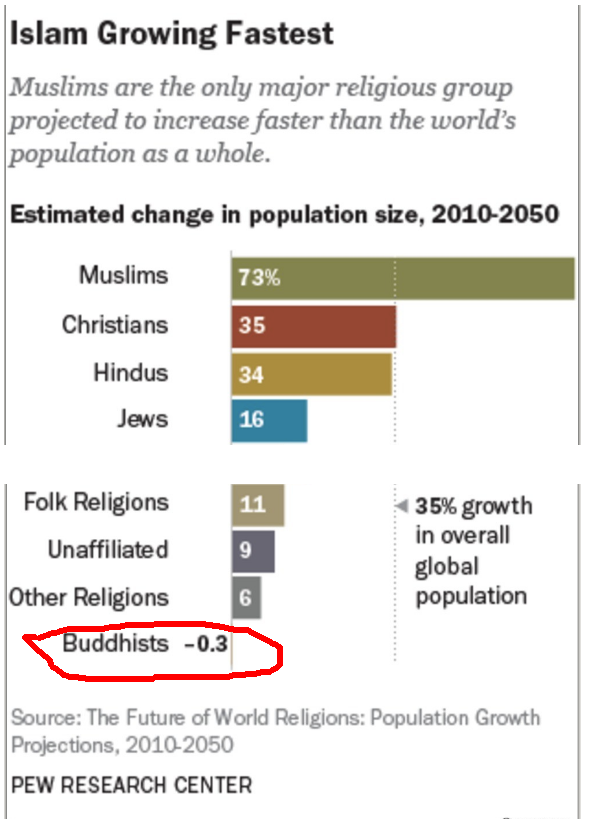新千年的佛教
Buddhism in the New Millennium
加拿大佛教会会长、湛山精舍住持 释达义
President of The Buddhist Association of Canada
Abbot of Cham Shan Temple Venerable Dayi SHI
Publish: 2017-12-24 09:22:26 Author: Ven. Dayi Shi Source: Cham Shan Temple
佛教面临的新挑战及自身的突破
How Buddhism faces challenges beyond itself
Introduction
1. The great values of Buddhism in the contemporary world
2. The current status and future prospect of Buddhism
3. Resolving five challenges, achieving new breakthroughs
4. Exploration and experience of The Buddhist Association of Canada Cham Shan Temple
Conclusion
Introduction
The three major religions of the world, Buddhism, Christianity and Islam all have undergone three development stages: primitive religion, ethnic religion and world religion.
Buddhism: started around 600 BCE. During the reign of Asoka (269 BCE to 232 BCE), Buddhism was widely promoted and eventually became the state religion in Ancient India. Missionaries were sent to neighbouring countries to preach, making Buddhism a world religion.
Christianity: the first Christian church was believed to be established in 33 CE. In 380 CE, Roman Emperor Theodosius formally established Christianity as the state religion, and this laid the foundation of the development of Christianity today.
Islam: was founded by Mohammed in 610 CE. Later the Arab Empire was established. Islam was propagated to the world through wars and trade.
From history, we can summarize the distinctions between Buddhism and other world religions:
1. Among the three major religions, Buddhism is the earliest and most ancient religion.
2. Buddhism, at its inception stage, had not experienced persecution like Christianity and Islam.
3. The major religions had all undergone a process with the support and advocacy of their rulers. Even during the later stage of Asoka’s reign, when Buddhism was widely promoted, other religions like Brahmanism and Jainism were still allowed to coexist. This type of religious policy became the tradition of later Indian monarchs.
Therefore, the characteristics of Buddhism propagation adhere to the concept of tolerance, peace, and harmony.
Buddhism has been propagated to all parts of the world over its 2500 years of development. It has made enormous contributions to the spread of world culture. But today Buddhism is facing some new challenges which are completely different from the past. The new challenges are contentious and from all sides. This resulted from both the development itself and the change of the external environment of the world. Thus, we should study them carefully and treat them seriously.
I. The great values of Buddhism in the contemporary world
Dharma is the truth of the universe, and the Buddha talked about the Ultimate Truth and Immeasurable Wisdom.
At that time, Siddharta seated himself beneath the Bodhi Tree gazing into the starry night, on the full moon day of the month, and attained perfect enlightenment. He then exclaimed, “Amazing! Amazing! All sentient beings possess the wisdom of the Tathagata, but they are ignorant and not enlightened because of their delusions and attachments.”
The Tathagata observed all beings in the Dharma realms with his pure, unobstructed eyes of wisdom and exclaimed, “Amazing! Amazing! Why do these beings, who possess the wisdom of the Tathagata, are ignorant and deluded, not seeing and not knowing? I must tell them the Way, so that they will no longer attach to their delusions, and find within themselves the universal wisdom of the Buddha.” <Avatamsaka Sutra: 80 Chapters>
The term “Anuttara-samyak-sambodhi” refers to the Buddha’s state of supreme and perfect enlightenment. According to Samyuttagama, there are three kinds of wisdom:
1. Pubbe-nivāsānussati Nāṇa: knowledge of previous lifetimes of self and others
2. Cutūpapāta Nāṇa: knowledge of future lifetimes of self and others
3. Āsavakkhaya Nāṇa: perfect understanding of present suffering and eradication of all defilements
More than 2000 years have passed. An increased number of scholars and intellectuals have accepted and applauded the wisdom of the Buddha. Despite social progress and advanced technology, the Buddha’s teachings have not in any way faded with the elapse of time. Instead, they become more awesome upon intense investigations and challenges.
According to the Buddhist scholar Mr. FANG Litian, philosophy is the essence of the spirit of the times, and Buddhism is a religious sect full of ideology. Buddhism is in accordance with the following standards:
Facilitate the development of a perfect personality
Contribute to social harmony
Help to connect and balance man and nature
Help to build a contemporary world civilization.
<Voice of Dharma 2010 3rd Volume>
My viewpoints are:
1. Dharma is in line with the trend of human social development
We can easily find obvious examples in both Buddhism doctrine and practice that illustrate the concepts advocated by modern civilized society, such as equality, fraternity, democracy and others.
The first example is the concept of equality. Buddhism at the very beginning opposed the concept of Brahmin first; instead it emphasized “Four Surname Equality” in relation to causes and conditions and the practice of emancipation. Every sentient being has Buddha-nature. Equality, according to the Buddha, is complete equality among all beings. Theoretically, the emphasis is on “Four Reliances” (Rely on the Dharma, not on individual teachers; Rely on the meaning, not on the words; Rely on wisdom, not on knowledge; Rely on the ultimate truth, not on relative truth). In the practice of Buddhism, while emphasizing the significance of taking refuges in the three jewels, it also points out equality between monastics and laities, equality between Buddhists and not-Buddhists.
Another example is the notion of democracy. When the Buddha entered nirvana, he did not designate anyone as his successor. Moreover, the Buddhist precepts dictate that all matters should be handled by majority rules. Specifically, it is a voting system. Spirit of democracy is one important element in a Buddhist organization, and this is in line with modern civilization.
2. Dharma is in line with the direction of scientific exploration
The advance of technology did not make the ancient religion of Buddhism obsolete; on the contrary, the development of technology has led to the discovery of more Buddhist insights.
As in the relationship between time and space, the Buddha has already profoundly discussed the interaction between psychology and physiology. As Buddhist practitioners, we are not surprised by new trendy scientific terms, such as multiple universes, time illusion, quantum entanglement, etc. In recent years, many seminars titled “Buddhism and Science” have been held in both academia and Buddhist communities. There are many examples like this, and I am not going to list them all here.
3. Dharma is in line with solving contemporary social problems and contradictions
Despite advanced technology in the modern world, people are impetuous, as stated in Lotus Sutra: “There is no peace in the three realms. Like a house on fire, it is full of fear and suffering.” Besides prosperity and progress, the world also encounters disasters and wars. In these circumstances, Buddhism advocates “transformation starts in the mind”. Indeed, it is correct to begin with the training of the mind.
In a word, the world needs Dharma to bring peace. It needs Dharma to address environmental issues. It needs Dharma to solve human psychological problems. It needs Dharma to advance the spirituality of mankind.
II. Current status and future prospect of Buddhism
1. Current status of Buddhism propagation in comparison with other world religions
Compared with other world religions, three features characterize Buddhism:
1.1 Among the three world religions, the number of Buddhists is the lowest.
Just based on the number of believers, Buddhism cannot enter the group of the three world religions, since the number of Hindus is twice that of Buddhists. According to the report of World Religions Overview 2015 conducted by Pew Research Center, there are 2.2 billions Christians including Catholics. 1.6 billions Muslims, 1 billion Hindus, and 0.5 billion Buddhists. With the world population of 6.9 billions, 84% (roughly 5.8 billions) among them have religious beliefs. Christian accounts for 32%, and Muslim 23%.

1.2 Compared with the other two world religions, Buddhism is mainly distributed in the Asia-Pacific region.
The graph shows that Christian is still the most popular religion. Among the 157 countries globally, Christian has the largest number of believers. In another 49 countries, the majority of believers is Muslim. Hinduism is mainly concentrated in countries like India, Nepal, Mauritius, etc. Buddhism is the most concentrated religion mainly in the Asia-Pacific area.
1.3 The influence of Buddhism on world mainstream culture is not strong enough
Due to historical reasons, the propagation of Buddhism did not exert huge impact on the world mainstream culture. Apart from a few elites who believe in Buddhism, Christian almost dominates the Western society, while the Western culture is also in a dominant position globally.
1.4 Buddhism on most occasions is merely an academic subject rather than a belief, even in today’s proliferated multicultural society.
Take Canada as the example, the country where I live in. Christian accounts for 70.3-77.1%, Buddhism 1.1-3.6%, Muslims 2%, Hindus 1%, and Jewish 1.1%

Percentage of global population 2015 in different religions
2. The future prospect of Buddhism propagation
What is the future trend? We will make an analysis by comparing Buddhism with other major religions.
According to a study on Future of World Religions (2015) from Pew Research Center, in the next 40 years, Christianity will still be the largest religious group, but Muslims will grow faster than any other world religions.
The changes of world religious population are related to the places where religious people live and the fertility rate in that area. The report also projected by 2050, the number of Muslim population will almost be the same as the number of Christian population.


The investigation reveals several incredible predictions:
From the year 2010 to 2050, the Muslim population is expected to increase by 73%. By the year 2050, the Muslim population will account for 23.2% of the entire world population.
By 2050, Islam will replace Jewish and become the second largest religious group in the States.
By that time, Muslims will make up 10% of the European population.
India, the birthplace of Buddhism, will replace Indonesia in 2050 to be a country with the largest Muslim population.
The number of Buddhist population will be shrinking. Besides Buddhism, the number of other major religions, such as Christianity, Islam, Hinduism, and Judaism, will all increase. Moreover, this will happen under the situation that the number of unaffiliated and agnostic population will be declining overall. It is quite alerting to us.
This is the most relevant and shocking information to us as well.

The report of Pew Research Center calls the leaders of all countries to be aware of the trend of rising and decreasing of the major religions and find measures to lower the potential conflict as early as possible.
In connection with the reality in China, the common sense is that even if the number of affiliated people is descending, they may not choose Buddhism as their first choice.
In modern China’s big five religions and folk beliefs, there is no doubt that Buddhism has the most profound impact on Chinese society, and the mission of Buddhism in transforming the modern society is arduous. In order to understand Chinese Buddhism better, we have to clearly examine the vast number of people, its long history, the profound theory and foundation, different social classes, and the arduous mission. (Blueprint of Religion: Report on Chinese Religion 2011, pages 21-22, published in July, 2011 by Social Sciences Literature Publication)
III. Resolving five challenges, achieving new breakthroughs
1. Challenge of the separation of valuable ideological resources of Buddhism from the contemporary world
The immense treasure and great value of Dharma is indispensable to the current society and the future world. But the reality is the separation of Buddhism from the world’s mainstream culture, and this is not to be desired. As a Buddhist and dharma practitioner, I have personal experience and sense of urgency in this matter.
2. Buddhist scripture is a big challenge to the busy people of today
Buddhism focuses on benefiting all sentient beings, with emphasis on progress and awakening of the human mind and morality. Nevertheless, Buddhist scripture is as vast and deep as the ocean, which is almost unfathomable. This presents difficulty to a lot of average readers. There is only one holy book for most other religions.
3. Challenge of worldly pursuit versus spiritual pursuit
When the world is working towards a unified economy, people are taking a multi-faith approach to religion. Cyber age creates a sense of segregation, and we hear the yearning and cries of the soul. These are worldly and spiritual issues we need to face. There are many Buddhist practitioners but few gain fruition. These are all issues we cannot ignore.
4. Challenge of expansive propagation area and language barrier
Buddhism was spread from ancient India. The three traditions, Theravada, Mahayana, and Vajryana, have undertaken Buddhist scripture translation for many years. Through the predecessors’ efforts, Buddhism stepped into the world. Chinese Buddhism had two important breakthroughs in its overseas propagation. The first one was completed in the Tang and Song Dynasties, when Buddhism was mainly propagated within the Chinese language circle with limited language barriers. The second one took place in 1960s and 1970s when Chinese Buddhism was spread to European and North American countries. The issue of language barrier outside the Chinese language circle became apparent.
5. Challenge in terms of human resource and means of communication in propagation
Man needs Dharma and Dharma definitely brings benefits to people. Mass media communication and community services are methods we have used to propagate Buddhism. We have encountered many difficulties. These are obstacles that the Buddhist organizations in China do not encounter. The biggest obstacle is the lack of multilingual monastics.
IV. Exploration and experience of The Buddhist Association of Canada
Cham Shan Temple
1. Emphasis on sutra translation and library service
Canada is a sparsely populated country with vast land and a society that embraces diversity in culture and faith. The Buddhist Association of Canada Cham Shan Temple engage actively in translating Chinese sutras into English, French, Spanish and building a library system which is open to the public.
China is the second hometown of Buddhism. When Buddhism of ancient India was first introduced to the west, the first issue was scripture translation. China has a long history of scripture translation, with the following main features:
Translators themselves were devout Buddhists, who considered Buddhist scripture translation a very sacred thing.
Translators themselves were seasoned practitioners with deep understanding of dharma. Examples are Venerable Masters Kumarajiv, Zhen Di, Xuan Zang, Yi Jing etc.
Buddhist scripture translation was considered a big project, supervised by the emperors in person. Translators were selected from nationwide, which is a condition difficult to replicate nowadays.
Three founding venerable masters of Cham Shan Temple emphasized the importance of Buddhist scripture translation. In particular, Elder Master Lok To dedicated his later life to scripture translation and made great achievements.
Ven. Master Lok To immigrated from Hong Kong to the United States in 1963. He established The Buddhist Association of the United States, The Young Men’s Buddhist Association of America, The Buddhist Association of San Francisco, and US-Canada Buddhist Sutra Translation Committee of The United States and Canada. After 10-year serving as chairman of The Buddhist Association of the United States and abbot of Da Jue Temple, in 1974, Venerable Master Lok To resigned from the positions and founded Young Men’s Buddhist Association of America. This monastery was established to focus on sutra translation work. After forty years’ efforts, Venerable Master Lok To had translated and published over 30 Mahayana scriptures into English for free distribution. Many of the translations have been republished and they had huge impact on the North American communities. Other than English, these Buddhist scriptures were also translated into French, Spanish, and Vietnamese. Thus, he was the first monk who had done Buddhist scripture translation in North America.
Under the guidance and supervision of Venerable Lok To, the following titles of Buddhist literature and sutras have been translated into English: The Dharma of Mind Transmission, The Sutra of Bodhisattva Ksitigarbha’s Fundamental Vows, A Composition Urging the Generation of the Bodhi Mind, The Prajna Paramita Heart Sutra, Practice and Attain Sudden Enlightenment, Pure Land Pure Mind, Mind-Seal of the Buddhas, Pure Land of the Patriarchs, Three Sutras on Complete Enlightenment, The Seeker’s Glossary of Buddhism, Brahma-Net Sutra, The Way of Fortune with Blessings, Selected Lectures of Dharma Master Fa-Fang, Samantabhadra: Supreme Vows, The Fundamentals of Meditation Practice, The Mahaparinirvana Sutra, and The Buddhist Liturgy.
2. Community service
In our exploration, we have summarized the practice of global exchange and community unity. The former refers to open-minded approaches that allow us to exchange views and learn from one another. In the application of Dharma, we need to understand society, connect communities, and enter families. With a broad vision of the future and a grounded approach in practice, Cham Shan Temple has become one of the most influential temples in Canada.
Each of Cham Shan’s ten affiliated temples has its own characteristics. Regular events are held every month to attract different race groups. The main activity for the Chinese community are ceremonial worship and dharma teaching. For other ethnic groups, we have staff who are knowledgeable in Buddhism and foreign language to promote Buddhism. Local police and education institutions organize frequent visits for their members to Cham Shan Temple, since they consider Chinese Buddhism as part of traditional Chinese culture. Groups that visit on a regular basis include Catholic schools, public schools, private schools, seniors, adults, mandarin, religion, medical care, women, police, Christians, Jews, and other ethnic churches in Ontario. Also, we have welcomed delegation from Royal Ontario Museum, university faculty and school teachers from Canada and the United States. Furthermore, since the inauguration on July 1, 2001, the Ten Thousand Buddhas Sarira Stupa, an affiliated temple of Cham Shan, located in the world famous Niagara Falls, has been offering free English-Chinese bilingual tours to introduce basic Buddhism to tourists from June to October of each year.
3. Diversification
As an overseas dharma propagator, I have some personal experience to share with everyone. Our audiences are mostly those who either do not speak Chinese or understand limited Chinese. Diversification is especially important. The majority of the second generation of the Chinese immigrants has better English language skills than Chinese. The traditional dharma teaching approach has inadequate effect, so we have to use a variety of means to fit the situation.
What Cham Shan Temple usually does is to actively promote Buddhist events in the Western communities. We normally start with activities such as meditation, vegetarianism, life protection, tea, and flower-arrangement. Then we teach them Buddhism and let them understand traditional Chinese culture and Dharma. We proactively introduce and propagate Buddhism to different race groups. Engaging staff with good knowledge of Buddhism to talk to students and visitors is a good way of planting seeds of Dharma in Canadian soil.
Another example is the multi-functional design of Wutai Shan Buddhist Garden in Canada. For the general public, it is an exhibition gallery. For Buddhists, it is a place of pilgrimage and learning. For the monastics, it is a training centre for exchange and development. Multi-function exhibition halls, multimedia dharma propagation, bilingual sutra lectures are necessary means of propagation.
After half a century’s hard work, Chinese Buddhism not only finds its place in North America but also receives recognition and respect from the mainstream society. Cham Shan Temple reaches this achievement from scratch. The propagation practice has been highly appraised by the three levels of government: federal, provincial, and municipal. In February 2013, Cham Shan Temple was awarded the Queen Elizabeth II Diamond Jubilee Medal. This award was presented by the Prime Minister of Canada in recognition of the contribution of The Buddhist Association of Canada Cham Shan Temple for their over 40 years of contribution in promoting Buddhism, serving the community, developing multiculturalism, promoting social harmony, facilitating relationship between China and Canada, as well as their outstanding contributions in charity and education.
Conclusion
What is the best way to cope with challenges? The answer is Dharma. Dharma is the key to every question.
1. Integrate into society through the practice of humanistic Buddhism
2. Develop progressive and multi-lingual lecturers, Vinaya and Chan masters to lead groups in the study and research of related subjects such as psychology, etc.
3. Develop a team consisting of Dharma protectors, donors and volunteers to serve the communities
4. Increase the impact of Buddhism by engaging experts of various fields in joining the Buddhist team
Where there is challenge, there is opportunity. Crisis opens chances for progress. Facing so many challenges, we must strengthen the authenticity of the Dharma and the sanctity of the Buddhist faith in order to revive Buddhism. Establishing a system of real Buddhism to propagate Dharma is the biggest contribution to human civilization.
Thank you